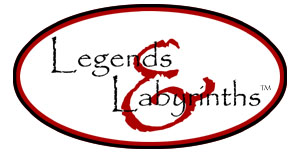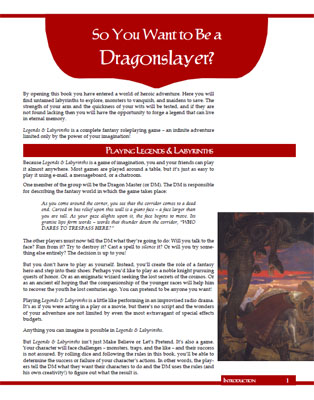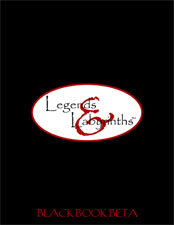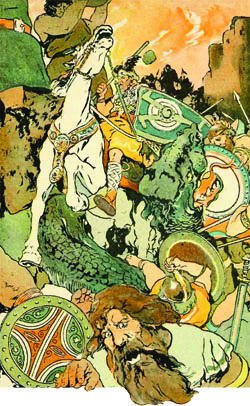 The earliest design goal for Legends & Labyrinths was to reveal the slick, tight, elegant system at the heart of 3rd Edition.
The earliest design goal for Legends & Labyrinths was to reveal the slick, tight, elegant system at the heart of 3rd Edition.
Like most RPGs, I’ve found that the secret to mastering 3rd Edition lies in finding the core principles on which the system is built — the essential mechanics from which everything else is built. And some of the first material ever developed for the game (even before it was a game) was written for online messageboards where I was attempting to share this mastery by demonstrating the simple, flexible core of the game in concrete terms.
In other words, Legends & Labyrinths was born out of a simple methodology: If it’s not a core mechanic, it’s not in the game.
This methodology naturally led me to re-examine character creation. Although 3rd Edition had created a system which made it possible to customize your character in myriad ways, if I wanted to design a game that was specifically friendly to new players then I knew it was important for Legends & Labyrinths to feature a streamlined character creation system. (This is something I’ll talk about more in the future, but it’s a design goal which only grew in importance once I started running an open table.)
After many tribulations and the pursuit of more than a few false ideals, I eventually brought the classic trio of character creation to Legends & Labyrinths: (1) Roll ability scores. (2) Pick class and race. (3) Buy equipment.
Character creation, however, led me inexorably to monster creation. Just as the designers of 3rd Edition had given players unprecedented control over their characters, they also gave DMs an unprecedented suite of tools and rules for creating and modifying monsters. It’s an impressive and powerful system, but it can also be overwhelming and time-consuming.
My initial impulse, as with character creation, was to simply roll back the clock: Strip out all of the advanced guidelines 3rd Edition offers for monster creation, include a bestiary of a few hundred nasty creatures, and then just leave it up to the DM to eyeball whatever stats looked appropriate when creating new beasties. That’s basically the way it was handled back in my original Basic Set, after all.
After some initial playtesting, however, it became clear that some sort of system for monster creation was necessary. This system went through several iterations and design cycles (being completely scrapped and restarting from scratch on at least two occasions). The system as it exists today, however, is heavily influenced from my experiences running the 1974 ruleset. What particularly struck me was that by simply setting a monster’s HD you immediately knew everything you needed to know about the monster’s stats. All you had to do was toss on a unique power or two and — blammo! — you had a monster. It was a process that took seconds, making it easy to spontaneously improvise entirely new creatures right at the game table without missing a beat.
It was out of this revelation that the Challenge Rating Table was born. (You can find it on page 123 of the Black Book Beta rulebook.) This table lies at the heart of the monster creation system in Legends & Labyrinths, and it led directly to the creation of what I came to think of as the “Three Pillars” of the game.
THE THREE PILLARS
The Three Pillars of Legends & Labyrinth are the monster creation system, the hazard/trap creation system, and the stunt system.
Let’s start with the monster creation system. Creating a monster in Legends & Labyrinths is a four step process:
- Pick a challenge rating.
- Select powers.
- Assign ability scores.
- Pick skills.
The CR of the creature determines is hit dice, armor class, attack bonus, attack damage, save bonus, the save DC for its special abilities, and the number of power ranks it receives. Powers are purchased using the monster’s power ranks, but the intention is that you pick a handful of significant powers and then quickly dump the rest into generic adjustments.
It should be noted that ability scores don’t modify any of the core stats determined by the monster’s CR. They only become relevant for ability score checks and skill checks. Nor are there any particular rules for picking the skills a monster gets: It’s assumed that the DM will exercise their best judgment in what skills a monster should possess.
(Playtest Tip: You want a copy of the Challenge Ratings Table on your DM screen. Just like the old “To Hit” tables, the CR table lets you pick a monster’s CR and then have all of its stats at your fingertips.)
When this simple, streamlined system finally clicked into place it was a major revelation. And I realized that its basic structure could be used to solve the problem I was having with traps. Here we come to the Second Pillar, in which hazards and traps are designed in a four step process:
- Pick a challenge rating.
- Define area/targets.
- Define effect.
- Define defense.
(For traps you also need to define a trigger.)
As the monster creation system is based in the Challenge Ratings Table, the hazard/trap creation system is based around the Hazards table. This table is one-half old school and one-half 4th Edition’s page 42. It contains general check DCs, trained check DCs, save DCs, attack bonuses, attack damage, repeating damage, and one-shot damage for every challenge rating.
Finally, we have the stunt system. The Legends & Labyrinths stunt system is a flexible method for allowing characters to perform unusual maneuvers during combat. A stunt can allow a character to apply a bonus to another character (or themselves), apply a penalty to another character, boost their speed or the speed of an ally, force opponents to move, or apply a variety of conditions to opponents. Resolving a stunt is a three step process:
- Define the effect of the stunt (which determines the DC).
- Perform the stunt by making the appropriate action check (usually a skill check).
- If successful, the target of the stunt may attempt a stunt save to negate its effect.
The DC of the stunt save is determined by the level or CR of the combatant performing the stunt, as shown on the Stunt Difficulty Class table.
USING THE THREE PILLARS
I started thinking of these systems — monster creation, hazard/trap creation, stunt creation — as the Three Pillars when I realized that the Challenge Ratings Table, the Hazards table, and the Stunt Difficulty Class table were all fundamentally joined. Not only do these tables share elements all cross-referenced by challenge rating (save DCs, attack bonuses, etc.), at a very real level they collectively form a single meta-table which defines the spine of the 3rd Edition ruleset.
(In fact, I actually considered unifying them all into one table for awhile. But I realized that although it can be useful to think of them as a single meta-table, from a utility standpoint they’re more effective as separate tables.)
What’s a reasonable save DC for a 9th level character? What’s a good target number for a skill check intended for a 15th level character? Whether you’re running Legends & Labyrinths or any 3rd Edition game, the meta-table of the Three Pillars gives you the answer (which you can then, of course, tweak to your heart’s content).
But more than that, I came to think of these systems as the Three Pillars because they form an important part of the foundation which makes up Legends & Labyrinths. One half of this game is “3rd Edition without the noise”; but the other half of the game is a suite of powerful new tools which can be used to revolutionize any 3rd Edition campaign.

CLIMB INTO YOUR LABYRINTH AND FORGE YOUR LEGEND TODAY!




 The earliest design goal for Legends & Labyrinths was to reveal the slick, tight, elegant system at the heart of 3rd Edition.
The earliest design goal for Legends & Labyrinths was to reveal the slick, tight, elegant system at the heart of 3rd Edition.










